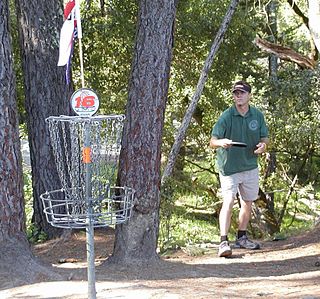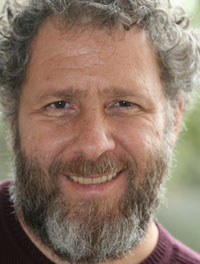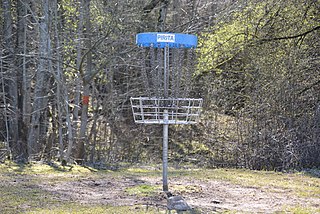Related Research Articles

Disc golf, formerly known as frisbee golf, is a flying disc sport in which players throw a disc at a target; it is played using rules similar to golf. Most disc golf discs are made out of polypropylene plastic, otherwise known as polypropene, which is a thermoplastic polymer resin used in a wide variety of applications. Discs are also made using a variety of other plastic types that are heated and molded into individual discs. The sport is usually played on a course with 9 or 18 holes (baskets). Players complete a hole by throwing a disc from a tee pad or area toward a target, known as a basket, throwing again from where the previous throw landed, until the basket is reached. The baskets are formed by wire with hanging chains above the basket, designed to catch the incoming discs, which then fall into the basket, for a score. Usually, the number of throws a player uses to reach each basket is tallied, and players seek to complete each hole in the lowest number of total throws. Par is the number of strokes an expert player is expected to make for a given hole or a group of holes.

A frisbee, also called a flying disc or simply a disc, is a gliding toy or sporting item that is generally made of injection-molded plastic and roughly 8 to 10 inches in diameter with a pronounced lip. It is used recreationally and competitively for throwing and catching, as in flying disc games. The shape of the disc is an airfoil in cross-section which allows it to fly by reducing the drag and increasing lift as it moves through the air, compared to a flat plate. Spinning the disc imparts a stabilizing gyroscopic force, allowing it to be both aimed with accuracy and thrown for distance.

The Professional Disc Golf Association (PDGA) is a 501(c)(4) nonprofit membership organization dedicated to the promotion and sustainable growth of disc golf. The PDGA is the global governing body of disc golf. The organization promotes the sport through tournament development, course development, rules and competitive standards, media and sponsor relations, and public education and outreach.

The World Flying Disc Federation (WFDF) is the international governing body for flying disc (Frisbee) sports, with responsibility for sanctioning world championship events, establishing uniform rules, setting of standards for and recording of world records. WFDF is a federation of member associations which represent flying disc sports and their athletes in 100 countries. WFDF is an international federation recognized by the International Olympic Committee (IOC), a member of the Association of IOC Recognised International Sports Federations (ARISF), GAISF, and the International World Games Association (IWGA), and it is a registered not-for-profit 501(c)(3) corporation in the state of Colorado, U.S.

Sedgley Woods is a section of east Fairmount Park, Philadelphia, Pennsylvania, and a historical disc golf course site. The site was established in 1977. It has one of the oldest permanent pole-hole disc golf courses. Friends of Sedgley Woods, a volunteer organization, maintains the grounds, runs monthly tournaments, community outreach programs, and occasional events in conjunction with the Mid-Atlantic Disc Club and the Professional Disc Golf Association.

Flying disc sports are sports or games played with discs, often called by the trademarked name Frisbees. Ultimate and disc golf are sports with substantial international followings.

Tom Monroe is a champion of virtually all flying disc sports, including ultimate, freestyle, field events and especially disc golf.

John Houck was born May 15, 1960, in Long Beach, California. He has designed more Championship disc golf courses than anyone living today. Since 1983, he has been devoted to the evolution and promotion of disc sports, including golf, ultimate, and freestyle, with a focus on the growth of disc golf since 1988.
The United States Disc Golf Championship is a disc golf tournament held at the Winthrop Gold Course, on the campus of Winthrop University in Rock Hill, South Carolina. The professional event has been held annually as a PDGA sanctioned Major since 1999. Along with the PDGA World Championships, it is one of the most prestigious major tournaments in disc golf. The primary sponsor for the event since its beginnings in 1999 has been Innova Champion Discs, a prominent disc manufacturer. Ken Climo currently holds a record five US Disc Golf Championships. The 2016 USDGC champion, Jeremy "Big Jerm" Koling, was leading the tournament after the third round. He was declared the winner when the fourth round was canceled due to inclement weather produced by Hurricane Matthew.
Stancil E. D. Johnson (1933–2021) was a psychiatrist and frisbee enthusiast.
Disc Golf Association (DGA) is a company founded in 1976 by Ed Headrick and located in Watsonville, California. The Disc Golf Association | DGA, is the founding company of the sport of disc golf and was the acting overseeing body for the sport until the establishment of the Professional Disc Golf Association (PDGA). The PDGA was run by Ed Headrick and the DGA until 1982. They are a manufacturer of disc golf baskets for the sports of Disc Golf. The company does not have any retail stores, but rather sells disc golf courses to park departments, disc golf clubs, and private parties. The company also sells large quantities of discs and other related disc golf equipment to resalers and wholesalers around the world.

Kenneth Ray Westerfield is a pioneering Frisbee disc player.
Paul McBeth is an American professional disc golfer from Huntington Beach, California. He won the PDGA World Championships four times in a row and again in 2019 and 2022, making him a six-time champion. He has not finished outside the top 2 at a World championship for the past 10 years. McBeth was the top rated player of the PDGA in 2015, 2017, 2018, and again in 2019. He is widely considered to be the best disc golfer of the modern era.

Ed Headrick, also known as "Steady" Ed Headrick, was an American toy inventor. Headrick served in combat in the army in WWII and was a deep-sea welder. He is most well known as the father of both the modern-day Frisbee and of the sport and game of disc golf.
Toronto Island Park Disc Golf Course is a world-class 18-hole disc golf course located in Toronto, Ontario, Canada. Set on the western side of Ward's Island, the course offers a picturesque view of the Toronto skyline and was one of 12-time PDGA World Champion Ken Climo's favorite courses. It was established in 1980 by Toronto Island Disc Golf Experience (TIDE) in partnership with the City of Toronto Parks Department and expanded in 2017 by Christopher Lowcock. Toronto Island Park Disc Golf Course hosted the Disc Golf World Championships in 1987.
Schmitten Discgolf Parcours is a seasonal 18-hole disc golf course located in Zell am See, Austria. The course is set on a ski slope and progresses downhill. The first hole is 1,830 metres (6,000 ft) above sea level and the last hole is 430 metres (1,410 ft) lower. Established on 15 June 2009, it was the first disc golf course in Austria and the 3,000th course to be added to the PDGA Course Directory. It is open for free to players who purchased a valid cable car ticket.

Disc golf is a popular sport in the United States played at the recreational, club, and international competition levels.

A basket is by far the most common type of target used in disc golf. It features a disc-catching basket under a deflection assembly generally made out of chain. Permanent baskets on courses are built on an anchored metal pole, but portable disc golf baskets with foldable mechanisms to facilitate transportation also exist.

Disc golf is a popular sport in Estonia, where it is played at the recreational, club, and international competition levels.

The COVID-19 pandemic has caused disruption to disc golf across the world, mirroring its impact across all sports. Throughout the world and to varying degrees, leagues and competitions have been cancelled or postponed.
References
- ↑ Altmyer, Don (2011). "Kevin Donnelly: Disc Golf". Disc Golfer (Fall 2011).
- ↑ Gregoire, Matt (2008-09-23). "Brief History of Disc Golf and the PDGA". Professional Disc Golf Association. Retrieved 2017-05-11.
- ↑ "History of Frisbee and Flying Disc freestyle". Development of Frisbee and disc sports. Retrieved April 6, 2018.
- ↑ "Greater Rochester Disc Golf Club" . Retrieved December 25, 2017.
- ↑ "History of Ultimate Frisbee and Disc Sports" . Retrieved December 25, 2017.
- ↑ Anonymous (2008-09-23). "Brief History of Disc Golf and the PDGA". Professional Disc Golf Association. Retrieved 2018-04-18.
- 1 2 "About Ed Headrick". Disc Golf Association. Retrieved 7 May 2020.
- ↑ "Brief History of Disc Golf and the PDGA". Professional Disc Golf Association. Retrieved 7 May 2020.
- ↑ Flying disc entrapment device, 1976-04-19, retrieved 2018-04-18
- ↑ "About Ed Headrick - Father of Disc Golf - DGA | Disc Golf Association". DGA | Disc Golf Association. Retrieved 2017-05-11.
- ↑ Gregoire, Matt (2015-01-30). "Disc Golf Hall Of Fame". Professional Disc Golf Association. Retrieved 2017-05-11.
- ↑ "Innova - The Choice Of Champions - #1 in Disc Golf - Innova Disc Golf". innovadiscs.com. Retrieved 2017-05-11.
- ↑ "Ed Headrick, Designer of the Modern Frisbee, Dies at 78". New York Times. Retrieved 2002-06-14.
- ↑ "The History of Disc Golf". Discgolf.com. Retrieved 2011-12-27.
- ↑ US 4039189
- ↑ "Archive: 1978 Disc Golf Association Disc Golf Promotional Development Guide. PDF 11 pages" (PDF). Discgolf.com. Archived from the original (PDF) on 15 April 2012. Retrieved 2013-09-29.